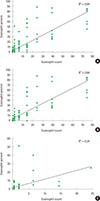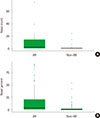Abstract
Purpose
Allergic rhinitis is the most common atopic disease and the most common chronic disease of children. Eosinophil count and percentage in nasal smear are useful for differential diagnosis of allergic rhinitis. The aim of this study is to investigate the correlation between nasal eosinophil count and percentage.
Methods
Between January 2017 and August 2018, 221 children patients with a clinical history of rhinitis were tested at the outpatient respiratory and allergy unit of the Department of Pediatrics, School of Medicine, The Catholic University of Korea. Nasal secretion was collected by swabbing a children's nasal inferior turbinate 3–4 times with a cotton swab and then placed on to a glass slide. Later, the smear was stained by Giemsa stain.
Results
This is the first study to assess the comparison of nasal eosinophil count and percent. There is a positive correlation between nasal eosinophil count and percent Y=1.02 X+2.82 (Y=Eosinophil count, X=Eosinophil percentage). To determine the usefulness of nasal eosinophil count and percentage in the diagnosis of allergic rhinitis, we analyzed receiver operating characteristic curves. The cutoff value of the nasal eosinophil count was 6.5/high-power field, and that of the nasal eosinophil ratio was 3% for the diagnosis of allergic rhinitis.
Figures and Tables
 | Fig. 1(A) Correlation between nasal eosinophil count and nasal eosinophil percentage in all patients. (B) Correlation between nasal eosinophil count and nasal eosinophil percentage in the children with AR. (C) Correlation between nasal eosinophil count and nasal eosinophil percentage in the children with non-AR. AR, allergic rhinitis. |
 | Fig. 2(A) The mean value of nasal eosinophil counts in the children with AR was higher than the children with non-AR. (B) The mean value of nasal eosinophil percentage in the children with AR was higher than the children with non-AR. AR, allergic rhinitis. |
 | Fig. 3(A) Comparison of areas under the receiver operating characteristic curves between nasal eosinophil counts for diagnosis of AR. The area under the curve was 0.71 (95% confidence interval [CI], 0.65–0.77; P<0.01) and the optimal cutoff value to distinguish patients with AR was 6.5/HFP. AR, allergic rhinitis. (B) Comparison of areas under the receiver operating characteristic curves between nasal eosinophil percentage for diagnosis of AR. The area under the curve was 0.71 (95% CI, 0.65–0.78; P<0.01) and the optimal cutoff value to distinguish patients with AR was 3%. AR, allergic rhinitis. |
References
1. Brożek JL, Bousquet J, Agache I, Agarwal A, Bachert C, Bosnic-Anticevich S, et al. Allergic Rhinitis and its Impact on Asthma (ARIA) guidelines-2016 revision. J Allergy Clin Immunol. 2017; 140:950–958.

2. Hwang SH, Jung SY, Lim DH, Son BK, Kim JH, Yang JM, et al. Epidemiology of allergic rhinitis in Korean children. Allergy Asthma Respir Dis. 2013; 1:321–332.

3. Rha YH. Allergic rhinitis in children: diagnosis and treatment. Korean J Pediatr. 2006; 49:593–601.

4. Hamilton RG, Franklin Adkinson N Jr. In vitro assays for the diagnosis of IgE-mediated disorders. J Allergy Clin Immunol. 2004; 114:213–225.


5. Chen ST, Sun HL, Lu KH, Lue KH, Chou MC. Correlation of immunoglobulin E, eosinophil cationic protein, and eosinophil count with the severity of childhood perennial allergic rhinitis. J Microbiol Immunol Infect. 2006; 39:212–218.

6. Kemp AS, Simpson J, Mellis CM. The significance of nasal eosinophils and mast cells in children with nasal symptoms. Int J Pediatr Otorhinolaryngol. 1982; 4:293–299.


7. Ciprandi G, Vizzaccaro A, Cirillo I, Tosca M, Massolo A, Passalacqua G. Nasal eosinophils display the best correlation with symptoms, pulmonary function and inflammation in allergic rhinitis. Int Arch Allergy Immunol. 2005; 136:266–272.


8. Ahmadiafshar A, Taghiloo D, Esmailzadeh A, Falakaflaki B. Nasal eosinophilia as a marker for allergic rhinitis: a controlled study of 50 patients. Ear Nose Throat J. 2012; 91:122–124.


9. Amorim MM, Araruna A, Caetano LB, Cruz AC, Santoro LL, Fernandes AL. Nasal eosinophilia: an indicator of eosinophilic inflammation in asthma. Clin Exp Allergy. 2010; 40:867–874.


10. Miller RE, Paradise JL, Friday GA, Fireman P, Voith D. The nasal smear for eosinophils. Its value in children with seasonal allergic rhinitis. Am J Dis Child. 1982; 136:1009–1011.

11. Sonawane R, Ahire N, Patil S, Korde A. Study of eosinophil count in nasal and blood smear in allergic respiratory diseases. MVP J Med Sci. 2016; 3:44–51.

12. Crobach M, Hermans J, Kaptein A, Ridderikhoff J, Mulder J. Nasal smear eosinophilia for the diagnosis of allergic rhinitis and eosinophilic non-allergic rhinitis. Scand J Prim Health Care. 1996; 14:116–121.






 PDF
PDF ePub
ePub Citation
Citation Print
Print




 XML Download
XML Download